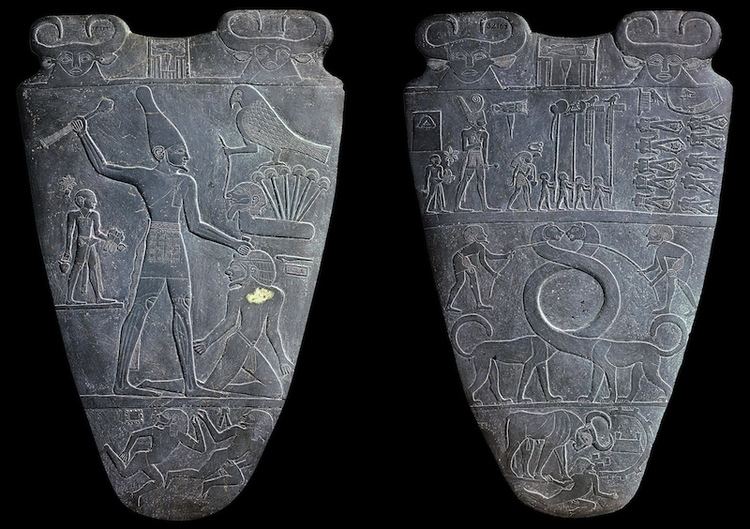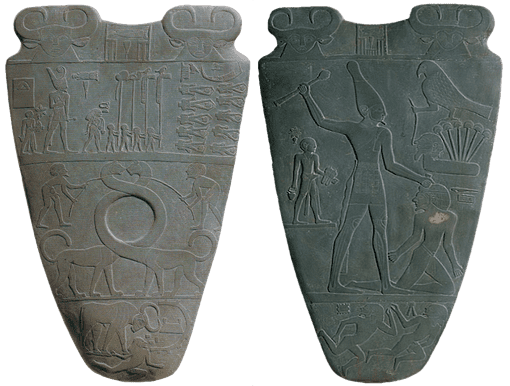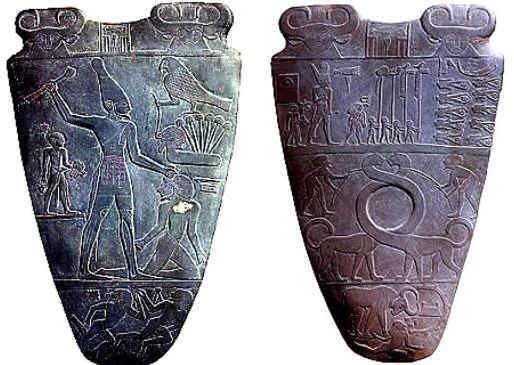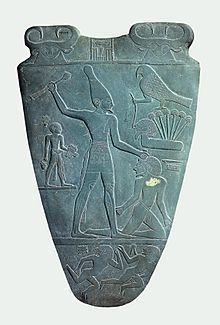Size c. 64 cm x 42 cm Identification CG 14716 | Discovered 1897-1898 Material Siltstone | |
 | ||
Created 31st century BC (circa) Similar The Seated Scribe, Victory Stele of Naram‑Sin, Stela of Akhenaten and his fa, Standard of Ur, Warka Vase | ||
The Narmer Palette, also known as the Great Hierakonpolis Palette or the Palette of Narmer, is a significant Egyptian archeological find, dating from about the 31st century BC. It contains some of the earliest hieroglyphic inscriptions ever found. The tablet is thought by some to depict the unification of Upper and Lower Egypt under the king Narmer. On one side, the king is depicted with the bulbed White Crown of Upper (southern) Egypt, and the other side depicts the king wearing the level Red Crown of Lower (northern) Egypt. Along with the Scorpion Macehead and the Narmer Maceheads, also found together in the Main Deposit at Nekhen, the Narmer Palette provides one of the earliest known depictions of an Egyptian king. The Palette shows many of the classic conventions of Ancient Egyptian art, which must already have been formalized by the time of the Palette's creation. The Egyptologist Bob Brier has referred to the Narmer Palette as "the first historical document in the world".
Contents
- Narmer palette
- Description
- Recto Side
- Verso Side
- Scholarly debate on the Palette
- In popular culture
- References

The Palette, which has survived five millennia in almost perfect condition, was discovered by British archeologists James E. Quibell and Frederick W. Green, in what they called the Main Deposit in the Temple of Horus at Nekhen, during the dig season of 1897–98. Also found at this dig were the Narmer Macehead and the Scorpion Macehead. The exact place and circumstances of these finds were not recorded very clearly by Quibell and Green. In fact, Green's report placed the Palette in a different layer one or two yards away from the deposit, which is considered to be more accurate on the basis of the original excavation notes. It has been suggested that these objects were royal donations made to the temple. Nekhen, or Hierakonpolis, was the ancient capital of Upper Egypt during the pre-dynastic Naqada III phase of Egyptian history.

Palettes were typically used for grinding cosmetics, but this palette is too large and heavy (and elaborate) to have been created for personal use and was probably a ritual or votive object, specifically made for donation to, or use in, a temple. One theory is that it was used to grind cosmetics to adorn the statues of the gods.

The Narmer Palette is part of the permanent collection of the Egyptian Museum in Cairo. It is one of the initial exhibits which visitors have been able to see when entering the museum. It has the Journal d'Entrée number JE32169 and the Catalogue Général number CG14716.

Narmer palette
Description

The Narmer Palette is a 63-centimetre tall (2.07 ft), shield-shaped, ceremonial palette, carved from a single piece of flat, soft dark gray-green siltstone. The stone has often been wrongly identified, in the past, as being slate or schist. Slate is layered and prone to flaking, and schist is a metamorphic rock containing large, randomly distributed mineral grains. Both are unlike the finely grained, hard, flake-resistant siltstone, whose source is from a well-attested quarry that has been used since pre-dynastic times at Wadi Hammamat. This material was used extensively during the pre-dynastic period for creating such palettes and also was used as a source for Old Kingdom statuary. A statue of the 2nd dynasty pharaoh Khasekhemwy, found in the same complex as the Narmer Palette at Hierakonpolis, also was made of this material.

Both sides of the Palette are decorated, carved in raised relief. At the top of both sides are the central serekhs bearing the rebus symbols n'r (catfish) and mr (chisel) inside, being the phonetic representation of Narmer's name. The serekh on each side are flanked by a pair of bovine heads with highly curved horns, thought to represent the cow goddess Bat. She was the patron deity of the seventh nome of Upper Egypt, and was also the deification of the cosmos within Egyptian mythology during the pre-dynastic and Old Kingdom periods of Ancient Egyptian history.
The Palette shows the typical Egyptian convention for important figures in painting and reliefs of showing the striding legs and the head in profile, but the torso as from the front. The canon of body proportion based on the "fist", measured across the knuckles, with 18 fists from the ground to the hairline on the forehead is also already established. Both conventions remained in use until at least the conquest by Alexander the Great some 3,000 years later. The minor figures in active poses, such as the king's captive, the corpses and the handlers of the serpopard beasts, are much more freely depicted.
Recto Side
As on the other side, two human-faced bovine heads, thought to represent the patron cow goddess Bat, flank the serekhs. The goddess Bat is, as she often was, shown in portrait, rather than in profile as is traditional in Egyptian relief carving. Hathor, who shared many of Bat's characteristics, is often depicted in a similar manner. Some authors suggest that the images represent the vigor of the king as a pair of bulls.
A large picture in the center of the Palette depicts Narmer wielding a mace wearing the White Crown of Upper Egypt (whose symbol was the flowering lotus). On the left of the king is a man bearing the king's sandals, once again flanked by a rosette symbol. To the right of the king is a kneeling prisoner, who is about to be struck by the king. A pair of symbols appear next to his head, perhaps indicating his name or indicating the region where he was from. Above the prisoner is a falcon, representing Horus, perched above a set of papyrus flowers, the symbol of Lower Egypt. In his talons, he holds a rope-like object which appears to be attached to the nose of a man's head that also emerges from the papyrus flowers, perhaps indicating that he is drawing life from the head. The papyrus has often been interpreted as referring to the marshes of the Nile Delta region in Lower Egypt, or that the battle happened in a marshy area, or even that each papyrus flower represents the number 1,000, indicating that 6,000 enemies were subdued in the battle.
Below the king's feet is a third section, depicting two naked, bearded men. They are either running or are meant to be seen as sprawling dead upon the ground. Appearing to the left of the head of each man is a hieroglyphic sign, the first a walled town, the second a type of knot, probably indicating the name of a defeated town.
Verso Side
Below the bovine heads is what appears to be a procession. Narmer is depicted at nearly the full height of the register, emphasizing his god-like status in an artistic practice called hierarchic scale, shown wearing the Red Crown of Lower Egypt, whose symbol was the papyrus. He holds a mace and a flail, two traditional symbols of kingship. To his right are the hieroglyphic symbols for his name, though not contained within a serekh. Behind him is his sandal-bearer, whose name may be represented by the rosette appearing adjacent to his head, and a second rectangular symbol that has no clear interpretation but which has been suggested may represent a town or citadel. Immediately in front of the pharaoh is a long-haired man, accompanied by a pair of hieroglyphs that have been interpreted as his name: Tshet (this assumes that these symbols had the same phonetic value used in later hieroglyphic writing). Before this man are four standard bearers, holding aloft an animal skin, a dog, and two falcons. At the far right of this scene are ten decapitated corpses, with heads at their feet, possibly symbolizing the victims of Narmer's conquest. Above them are the symbols for a ship, a falcon, and a harpoon, which has been interpreted as representing the names of the towns that were conquered.
Below the procession, two men are holding ropes tied to the outstretched, intertwining necks of two serpopards confronting each other. The serpopard is a mythological creature whose name is a portmanteau of the words "serpent" and "leopard" (though the spotless beast with tufted tail more closely resembles a lioness.) The circle formed by their curving necks is the central part of the Palette, which is the area where the cosmetics would have been ground. Upper and Lower Egypt each worshipped lioness war goddesses as protectors; the intertwined necks of the serpopards may thus represent the unification of the state. Similar images of such mythical animals are known from other contemporaneous cultures, and there are other examples of late-predynastic objects (including other palettes and knife handles) which borrow similar elements from Mesopotamian iconography.
At the bottom of the Palette, a bovine image is seen knocking down the walls of a city while trampling on a fallen foe. Because of the lowered head in the image, this is interpreted as a presentation of the king vanquishing his foes, "Bull of his Mother" being a common epithet given to Egyptian kings as the son of the patron cow goddess. This posture of a bovine has the meaning of "force" in later hieroglyphics.
Scholarly debate on the Palette
The Palette has raised considerable scholarly debate over the years. In general, the arguments fall into one of two camps: scholars who believe that the Palette is a record of actual events, and other academics who argue that it is an object designed to establish the mythology of united rule over Upper and Lower Egypt by the king. It had been thought that the Palette either depicted the unification of Lower Egypt by the king of Upper Egypt or recorded a recent military success over the Libyans or the last stronghold of a Lower Egyptian dynasty based in Buto. More recently, scholars such as Nicholas Millet have argued that the Palette does not represent a historical event (such as the unification of Egypt), but instead represents the events of the year in which the object was dedicated to the temple. Whitney Davis has suggested that the iconography on this and other pre-dynastic palettes has more to do with establishing the king as a visual metaphor of the conquering hunter caught in the moment of delivering a mortal blow to his enemies. John Baines has suggested that the events portrayed are "tokens of royal achievement" from the past and that "the chief purpose of the piece is not to record an event but to assert that the king dominates the ordered world in the name of the gods and has defeated internal, and especially external, forces of disorder".
In popular culture
The Narmer Palette is featured in the 2009 film Watchmen. The Australian author Jackie French used the Palette, and recent research into Sumerian trade routes, to create her historical novel Pharaoh (2007). The Palette is featured in manga artist Yukinobu Hoshino's short story "The temple of El Alamein". The Palette is also featured in The Kane Chronicles by Rick Riordan where the actual palette is fetched by a magical shwabati servant instead of just a picture to Carter's utter horror.
